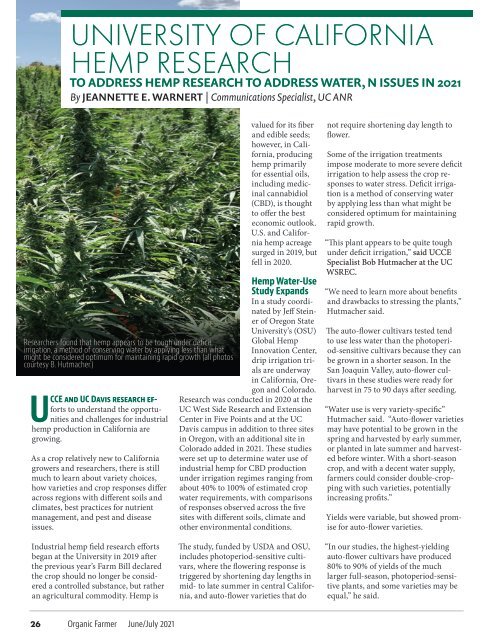Create successful ePaper yourself
Turn your PDF publications into a flip-book with our unique Google optimized e-Paper software.
UNIVERSITY <strong>OF</strong> CALIFORNIA<br />
HEMP RESEARCH<br />
TO ADDRESS HEMP RESEARCH TO ADDRESS WATER, N ISSUES IN <strong>2021</strong><br />
By JEANNETTE E. WARNERT | Communications Specialist, UC ANR<br />
Researchers found that hemp appears to be tough under deficit<br />
irrigation, a method of conserving water by applying less than what<br />
might be considered optimum for maintaining rapid growth (all photos<br />
courtesy B. Hutmacher.)<br />
UCCE and UC Davis research efforts<br />
to understand the opportunities<br />
and challenges for industrial<br />
hemp production in California are<br />
growing.<br />
As a crop relatively new to California<br />
growers and researchers, there is still<br />
much to learn about variety choices,<br />
how varieties and crop responses differ<br />
across regions with different soils and<br />
climates, best practices for nutrient<br />
management, and pest and disease<br />
issues.<br />
valued for its fiber<br />
and edible seeds;<br />
however, in California,<br />
producing<br />
hemp primarily<br />
for essential oils,<br />
including medicinal<br />
cannabidiol<br />
(CBD), is thought<br />
to offer the best<br />
economic outlook.<br />
U.S. and California<br />
hemp acreage<br />
surged in 2019, but<br />
fell in 2020.<br />
Hemp Water-Use<br />
Study Expands<br />
In a study coordinated<br />
by Jeff Steiner<br />
of Oregon State<br />
University’s (OSU)<br />
Global Hemp<br />
Innovation Center,<br />
drip irrigation trials<br />
are underway<br />
in California, Oregon<br />
and Colorado.<br />
Research was conducted in 2020 at the<br />
UC West Side Research and Extension<br />
Center in Five Points and at the UC<br />
Davis campus in addition to three sites<br />
in Oregon, with an additional site in<br />
Colorado added in <strong>2021</strong>. These studies<br />
were set up to determine water use of<br />
industrial hemp for CBD production<br />
under irrigation regimes ranging from<br />
about 40% to 100% of estimated crop<br />
water requirements, with comparisons<br />
of responses observed across the five<br />
sites with different soils, climate and<br />
other environmental conditions.<br />
not require shortening day length to<br />
flower.<br />
Some of the irrigation treatments<br />
impose moderate to more severe deficit<br />
irrigation to help assess the crop responses<br />
to water stress. Deficit irrigation<br />
is a method of conserving water<br />
by applying less than what might be<br />
considered optimum for maintaining<br />
rapid growth.<br />
“This plant appears to be quite tough<br />
under deficit irrigation,” said UCCE<br />
Specialist Bob Hutmacher at the UC<br />
WSREC.<br />
“We need to learn more about benefits<br />
and drawbacks to stressing the plants,”<br />
Hutmacher said.<br />
The auto-flower cultivars tested tend<br />
to use less water than the photoperiod-sensitive<br />
cultivars because they can<br />
be grown in a shorter season. In the<br />
San Joaquin Valley, auto-flower cultivars<br />
in these studies were ready for<br />
harvest in 75 to 90 days after seeding.<br />
“Water use is very variety-specific”<br />
Hutmacher said. “Auto-flower varieties<br />
may have potential to be grown in the<br />
spring and harvested by early summer,<br />
or planted in late summer and harvested<br />
before winter. With a short-season<br />
crop, and with a decent water supply,<br />
farmers could consider double-cropping<br />
with such varieties, potentially<br />
increasing profits.”<br />
Yields were variable, but showed promise<br />
for auto-flower varieties.<br />
Industrial hemp field research efforts<br />
began at the University in 2019 after<br />
the previous year’s Farm Bill declared<br />
the crop should no longer be considered<br />
a controlled substance, but rather<br />
an agricultural commodity. Hemp is<br />
The study, funded by USDA and OSU,<br />
includes photoperiod-sensitive cultivars,<br />
where the flowering response is<br />
triggered by shortening day lengths in<br />
mid- to late summer in central California,<br />
and auto-flower varieties that do<br />
“In our studies, the highest-yielding<br />
auto-flower cultivars have produced<br />
80% to 90% of yields of the much<br />
larger full-season, photoperiod-sensitive<br />
plants, and some varieties may be<br />
equal,” he said.<br />
26 Organic Farmer <strong>June</strong>/<strong>July</strong> <strong>2021</strong>


















